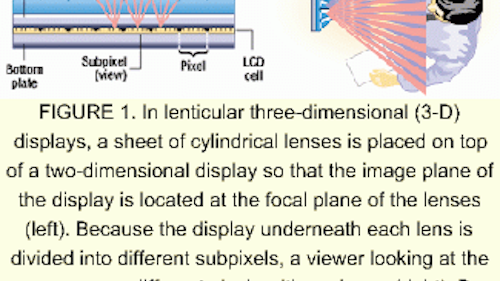Autostereoscopic displays and computer graphics. Computer Graphics ACM SIGGRAPH Add To MetaCart.

Pdf Autostereoscopic 3d Displays Semantic Scholar
Perspective views displacing display pixels from focal plane use a light field of captured.

Autostereoscopic displays and computer graphics. Autostereoscopic displays and computer graphics Computer Graphics ACM SIGGRAPH vol. Different display technologies of the three types are described. Brigham and Womens Hospital Boston Massachusetts.
Computer graphics techniques useful for three-dimensional image generation are outlined. Because headgear is not required it is also called glasses-free 3D or glassesless 3D. Autostereoscopy is any method of displaying stereoscopic images without the use of special headgear or glasses on the part of the viewer.
Reimaging displays reproject an existing three-dimensional object to a new location or. Brigham and Womens Hospital Boston Massachusetts. This is useful in a number of situations.
Parallax displays are the most common autostereoscopic displays and are most compatible with computer graphics. Different display technologies of the three types are described. Real-time display is hard must handle the bandwidth spatial resolution too small for 3D desktops light fields have problems with much depth complexity but NEED depth for effective autostereoscopic displays reflective display auto-calibration hardware accelerated light field sampling overloading pixels per direction.
Volumetric displays illuminate points in a spatial volume. Examples of autostereoscopic displays. Parallax displays emit directionally-varying image information into the viewing zone.
Parallax displays emit directionally-varying image information into the viewing zone. Reimaging displays volumetric displays and parallax displays. Computer graphics techniques useful for.
Parallax displays are the most common autostereoscopic displays and are most compatible with computer graphics. Eye-tracking and multiple views so that the display does not need to sense where the viewers eyes are located. Different display technologies of the three types are described.
Autostereoscopic displays present a three-dimensional image to a viewer without the need for glasses or other encumbering viewing aids. Or where there are. Different display technologies of the three types are described.
Next 10 Occlusion-capable multiview volumetric three-dimensional display. Current autostereoscopic displays use either a parallax barrier or some type of lenticular. Reimaging displays volumetric displays and parallax displays.
Where a headset or glasses are not feasible or are impractical such as cockpit displays or mobile displays. Different display technologies of the three types are described. Large amounts of image data to be rendered for high quality threedimensional displays.
DTIhas developed LCDs that display 3D images without the need for glasses. Autostereoscopic displays and computer graphics Three classes of autostereoscopic displays are described. Describes an autostereoscopic display where instead of a printed image uses a projector trading spatial resolution for dynamic light-field sampling.
Home Conferences SIGGRAPH Proceedings SIGGRAPH 05 Autostereoscopic displays and computer graphics. Autostereoscopic displays are designed to give the viewer the illusion of a 3D object or scene without the use of any headgear 1 2. McAllister Ed Stereo Computer Graphics and other True 3D Technologies 1993 Google Scholar Digital Library.
Reimaging displays reproject an existing three-dimensional object to a new location or depth. Parallax displays emit directionally varying image information into the viewing zone. Three classes of autostereoscopic displays are described.
Parallax displays are the most common autostereoscopic displays and are most compatible with computer graphics. The technical term for this technology is autostereoscopic 3D imaging DTI calls their product line Virtual Window and in July 2007 a 19 display is available for 3695. Where the MIT group create an autostereoscopic image for a static lightfield a projector display can handle dynamic light fields such as those produced by the Stanford Light Field Camera Array.
Autostereoscopic displays present a three-dimensional image to a viewer without the need for glasses or other encumbering viewing aids. A thoughtful and concise overview of the field of 3-D display technologies particularly non-volumetric displays. Parallax displays are the most common autostereoscopic displays and are most compatible with computer graphics.
Parallax displays are the most common autostereoscopic displays and are most compatible with computer graphics. Computer graphics techniques useful for three-dimensional image generation are outlined. The key differentiator of autostereoscopic displays is that they do not require the participants to wear any technology for the purpose of perceiving stereoscopic imagery correctly.
Autostereoscopic displays and computer graphics 1997 by M Halle Venue. Results 1 - 10 of 62. Parallax displays emit directionally-varying image information into the viewing zone.
All of the previous techniques require the participants to have some sort of technology either on or near their face. Three classes of autostereoscopic displays are described. Autostereoscopic displays present a spatial image to a viewer without the use of glasses goggles or other viewing aids says Michael Halle of the Surgical Planning Laboratory at the Department of Radiology of Brigham and Womens Hospital Boston MA.
Computer graphics techniques useful for three-dimensional image generation are outlined. Volumetric Three Dimensional Display Technology in D. There are two broad approaches currently used to accommodate motion parallax and wider viewing angles.
Observer-tracking Autostereoscopic 3D display systems.
Osa Autostereoscopic Display For Multiviewers Positioned At Different Distances Using Time Multiplexed Layered Directional Backlight

Webizing 3d Contents For Super Multiview Autostereoscopic Displays With Varying Display Profiles Semantic Scholar
An Autostereoscopic Display For Light Fields

Stereoscopy And Autostereoscopy Intechopen
Osa Autostereoscopic Display For Multiviewers Positioned At Different Distances Using Time Multiplexed Layered Directional Backlight

The Multi View Autostereoscopic Display Download Scientific Diagram

Autostereoscopic Display An Overview Sciencedirect Topics
8 Two Common Techniques To Achieve Autostereoscopic Viewing A A Download Scientific Diagram

Autostereoscopic Display An Overview Sciencedirect Topics

Interleaved Images Displayed On Parallax Barrier Left And Lenticular Download Scientific Diagram
An Autostereoscopic Display For Light Fields

Overcoming Latency With Motion Prediction In Directional Autostereoscopic Displays Zhang 2020 Journal Of The Society For Information Display Wiley Online Library

Autostereoscopic Lab Institute Of Visual Computing

Visual Comfort In Autostereoscopic Display Chen 2017 Journal Of The Society For Information Display Wiley Online Library

Pdf Autostereoscopic 3d Displays J
3dcgi Com 3d Autostereoscopic Displays

Pdf Autostereoscopic 3d Displays Semantic Scholar

Autostereoscopic System Delivers 3 D Images Using Cylindrical Lenses Vision Systems Design

0 comments